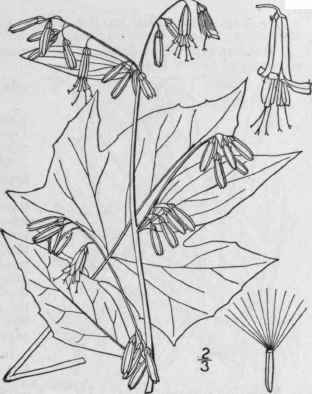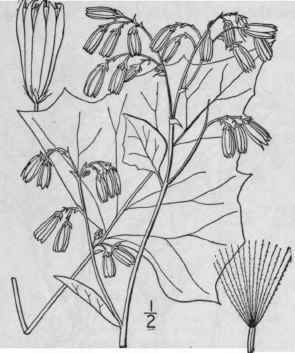23. Nabalus Cass. Dict. Sci. Nat. 34: 94. 1825
Description
This section is from the book "An Illustrated Flora Of The Northern United States, Canada And The British Possessions Vol3", by Nathaniel Lord Britton, Addison Brown. Also available from Amazon: An Illustrated Flora of the Northern United States, Canada and the British Possessions. 3 Volume Set..
23. Nabalus Cass. Dict. Sci. Nat. 34: 94. 1825
Perennial, herbs with alternate, mostly petioled, dentate lobed or pinnatifid leaves, or the upper auriculate and clasping, and numerous small heads of ligulate white yellowish or purplish flowers in open or spike-like terminal panicles, or also in axillary clusters, usually drooping. Involucre cylindric, usually narrow, its principal bracts in 1 or 2 series, nearly equal, with a few smaller exterior ones at the base. Receptacle flat, naked. Rays truncate and 5-toothed at the summit. Style-branches slender. Achenes oblong or narrowly columnar, truncate, terete or 4-5-angled, mostly 10-ribbed. Pappus of copious rather rigid simple white to reddish-brown bristles. [Modern Latin, from an Indian name for Rattlesnake-root.]
About 25 species, natives of America and Asia. Besides the following, two others occur in northwest America and one on the high mountains of North Carolina. Known by the general name of Rattlesnake-root or Drop-flower. Type species: Nabalus trifoliatus Cass. The European and African genus Prenanthes L. is here regarded as distinct from this.
* Bracts of the involucre glabrous, or with a few scattered hairs. Heads 15-7-flowered; involucre very narrow, light green, 1" thick; pappus light straw-color or brown.
1. N. altisstmus.
Heads 8-16-flowered; involucre broader, green, purple or glaucous, l1/2"-3" thick.
Leaves, or some of them, lobed, divided, or pinnatifid (sometimes entire in No. 3); involucre subcylindric, about 1 1/2" thick. Pappus deep cinnamon-brown.
2. N. albus.
Pappus straw-color or light brown. Inflorescence paniculate.
Involucral bracts with some stiff hairs, obviously shorter than the pappus; panicle-branches divergent.
3. N. serpentarius.
Involucral bracts glabrous, equalling the pappus; panicle-branches ascending, or upcurved.
4. N. trifoliolatus.
Inflorescence thyrsoid or glomerate.
Leaves palmately lobed or divided; northern.
5. N. nanus.
Leaves pinnately lobed or pinnatifid: southern.
6. N. virgatus.
Leaves entire or denticulate: plant low, alpine; involucre narrowly campanulate, 2 1/2"-3' thick.
7. N. Boottii.
** Bracts of the involucre hirsute-pubescent.
Inflorescence narrowly thyrsoid; heads 8-16-flowered. Leaves and stem rough-puberulent or scabrous.
8. N. asper.
Leaves and stem glabrous, glaucous.
9. N. racemosus.
Inflorescence corymbose-paniculate; heads 20-25-flowered.
10. N. crepidineus.
1. Nabalus Altissimus (L.) Hook. Tall White Lettuce
Fig. 4110
Prenanthes altissima L. Sp. PI. 797. 1753.
N. altissimus Hook. Fl. Bor. Am. 1: 294. 1833.
Glabrous, or sometimes hispidulous, not glaucous; stem slender, 3°-7° high, green, or sometimes purplish. Leaves thin, hastate, cordate, ovate, or the uppermost lanceolate, entire, denticulate, dentate or palmately lobed or divided, most of them long-petioled, the larger sometimes 6' long; heads very numerous, in a narrow panicle, and often in axillary clusters, 5-7-flowered, pendulous, about 2" broad; inflorescence often narrow; involucre narrowly cylindric, 5"-6" long, about 1" thick, green, glabrous, its principal bracts about 5; flowers greenish or yellowish white; pappus light straw-color, or cinnamon-brown.
In woods and thickets, Newfoundland to Manitoba, Missouri, Georgia and Louisiana. Lion's-foot. Rattlesnake-root. Ascends to 2500 ft. in the Catskills. Wild lettuce. Joy-leaf. Milk-weed. Bird-bell. Races differ in leaf-form, pubescence and in color of the pappus. July-Oct.


Continue to:


